Ampere Roadmap Update: Switching to In-House CPU Designs, 128+ 5nm Cores in 2022
by Andrei Frumusanu on May 19, 2021 11:00 AM EST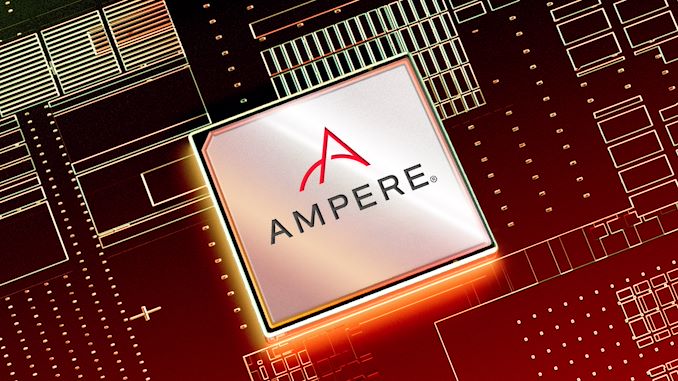
Today we’re covering some news of the more unusual type, and that is a roadmap update from Ampere, and having a closer look what the company is planning in terms of architectural and microarchitectural choices of their upcoming next-generation server CPUs in 2022 and onwards.
For people not familiar with Ampere, the company was founded back in 2017 by former Intel president Renée James, notably built upon a group of former Intel engineers who had left along with her to the new adventure. Initially, the company had relied on IP and design talent from former AppliedMicro’s X-Gene CPUs and still supporting legacy products such as the eMAG line-up.
With Arm having starting a more emphasised focus on designing and releasing datacentre and enterprise CPU IP line-ups in the form of the new Neoverse core offerings a few years back, over the last year or so we had finally seen the fruits of these efforts in the form of the release of several implementations of the first generation Neoverse N1 server CPU cores products, such as Amazon’s Graviton2, and more importantly, Ampere’s “Altra Quicksilver” 80-core server CPU.
The Altra Q line-up, for which we reviewed the flagship Q80-33 SKU last winter, was inarguably one of the most impressive Arm server CPU executions in past years, with the chip being able to keep up or beat the best AMD and Intel had to offer, even extending that positioning against the latest generation Xeon and EPYC generation.
Ampere’s next generation "Mystique" Altra Max is the next product on the roadmap, and is targeted to be sampling in the next few months and released later this year. The design relies on the same first generation Arm Neoverse N1 cores, at the same maximum 250W TDP as a drop-in replacement on the same platform, however with an optimised implementation that now allows for up to 128 CPU cores – 60% more cores than the first iteration of Altra we have today, and double the amount of cores of competitor systems from AMD or Amazon’s Graviton2.
For the future for designs beyond the Altra Max, Ampere is promising that they will be continuing emphasis of what they consider “predictable performance” for workloads with scaling socket load, increasing core counts with a linear increase in performance, and what I found interesting as a metric, to continue to reduce power per core – something to keep in mind as we’re discussing the next big news today:
Replacing Neoverse with Full Custom Cores
Today’s big reveal comes in regard to the microarchitecture choices that Ampere is going to be using starting in their next generation 2022 “Siryn” design, successor to the Altra Max, and relates to the CPU IP being used:
Starting with Siryn, Ampere will be switching over from Arm’s Neoverse cores to their new in-house full custom CPU microarchitecture. This announcement admittedly caught us completely off-guard, as we had largely expected Ampere to continue to be using Arm’s Neoverse cores for the foreseeable future. The switch to a new full custom microarchitecture puts Ampere on a completely different trajectory than we had initially expected from the company.
In fact, Ampere explains that what the move towards a full custom microarchitecture core design was actually always the plan for the company since its inception, and their custom CPU design had been in the works for the past 3+ years.
In terms of background - the design team leading the effort is lead by Ampere’s CTO Atiq Bajwa, who is also acting as the chief architect on the project. Bajwa and the team surrounding him appear to be mostly comprised of high-profile ex-Intel engineers and veterans which had left the company along with Renée James in 2017, topped-off with talent from a slew of other companies in the industry who joined them in the effort. The pedigree and history of the team is marked by achievements such as working on Intel’s Haswell and Broadwell processors.
Ampere’s explanation and rationale for designing a full custom core from the ground up, is that they are claiming they are able to achieve better performance and better power efficiency in datacentre workloads compared to what Arm’s Neoverse “more general purpose” designs are able to achieve. This is quite an interesting claim to make, and contrasts Arm’s projections and goals for their Neoverse cores. The recent Neoverse V1 and N2 cores were unveiled in more detail last month and are claimed to achieve significant generational IPC gains.
For Ampere to relinquish the reliance on Arm’s next-gen cores, and instead to rely on their own design and actually go forward with that switch in the next-gen product, shows a sign of great confidence in their custom microarchitecture design – and at the same time one could interpret it as a sign of no confidence in Arm’s Neoverse IP and roadmap. This comes at a great juxtaposition to what others are doing in the industry: Marvell has stopped development of their own ThunderX CPU IP in favour of adopting Arm Neoverse cores. On the other hand, not specifically related to the cloud and server market, Qualcomm earlier this year have acquired Nuvia, and their rationale and explanation was similar to Ampere’s in that they’re claiming that the new in-house design capabilities offered performance that otherwise wouldn’t have been possible with Arm’s Cortex CPU IP.
In our talks with Jeff Wittich, Ampere’s Chief Product Officer, he explains that today’s announcement should hopefully help paint a better picture of where Ampere is heading as a company – whether they’d continue to be content on “just” being an Arm IP integrator, or if they had plans for more. Jeff was pretty clear that in a few years’ time they’re envisioning and aiming for Ampere to be a top CPU provider for the cloud market and major player in the industry.
In terms of technical details as to how Ampere’s CPU microarchitecture will be different in terms of approach and how and why they see it as a superior performer in the cloud, are questions to which we’ll have to be a bit more patient for hearing answers to. The company wouldn’t comment on the exact status of the Siryn design right now – on whether it’s been taped in or taped out yet, but they do retierate that they’re planning customer sampling in early 2022 in accordance to prior roadmap disclosures. By the tone of the discussions, it seems the design is mostly complete, and Ampere is doing the finishing touches on the whole SoC. Jeff mentioned that in due time, they also will be doing microarchitectural disclosures on the new core, explaining their design choices in things like front-end or back-end design, and why they see it as a better fit for the cloud market.
Altra Max later this year, more cloud customer disclosures
Beyond the longer-term >2022 plans, today’s roadmap updates also contained a few more performance claim reiterations of Ampere’s upcoming 128-core Altra Max product, which is planned to hit the market later in the second half of the year and customers being sampled in the next few months.
The “Mystique” code-named Altra Max design will be characterised in that it’s able to increase the core-count by 60% versus the current generation Altra design, all while remaining at and below the same 250W TDP. The performance slides here are showcasing comparisons and performance claims against what is by now the previous generation competitor products, Ampere here simply explains they haven’t been able to get their hands on more recent Milan or Ice Lake-SP hardware to test. Nevertheless, the relative positioning against the Altra Q80-30 and the EPYC 7742 would indicate that the new chip would easily surpass the performance of even AMD’s latest EPYC 7763.
In the slide, Ampere actually discloses the SKU model name being used for the comparison, which is the "Altra Max M128-30" – meaning for the first time we have confirmation that all 128 cores are running at up to 3GHz clock speed, which is impressive given that we’re supposed to be seeing the same TDP and power characteristics between it and the Q80-33. We’ll be verifying these figures in the next few months once we get to review the Altra Max.
Today’s announcement also comes with an update on Ampere’s customers. Oracle was notably one of the first Altra adopters, but today’s disclosure also includes a wider range of cloud providers, with big names such as ByteDance and Tencent Cloud, two of the biggest hyperscalers in China.
Microsoft in particular is a big addition to the customer list, and while Ampere’s Jeff Wittich couldn’t comment on whether Microsoft has other internal plans in the works, he said that today’s announcement should give more clarity around the rumours of the Redmond company working on Arm-based servers, reports of which had surfaced back in December. Microsoft’s Azure cloud service is only second to Amazon’s AWS in terms of size and scale, and the company onboarding Altra products is a massive win for Ampere.
Taking control of one’s own future
Today’s announcements by Ampere of them deploying their own microarchitecture in future products is a major change in the company’s prospects. The news admittedly took us by surprise, but in the grand scheme of things it makes a lot of sense given that the company aims to be a major industry player in the next few years – taking full control of one’s own product future is critical in terms of assuring that success.
While over the years we’ve seen many CPU design teams be disbanded, actually having a new player and microarchitecture pop up is a much welcome change to the industry. While the news is a blow to Arm’s Neoverse IP, the fact that Ampere continues to use the Arm architecture is a further encouragement and win for the Arm ecosystem.
Related Reading:
- The Ampere Altra Review: 2x 80 Cores Arm Server Performance Monster
- Oracle Announces Upcoming Cloud Compute Instances: Ice Lake and Milan, A100 and Altra
- Next Generation Arm Server: Ampere’s Altra 80-core N1 SoC for Hyperscalers against Rome and Xeon
- Arm Announces Neoverse V1, N2 Platforms & CPUs, CMN-700 Mesh: More Performance, More Cores, More Flexibility
- Intel 3rd Gen Xeon Scalable (Ice Lake SP) Review: Generationally Big, Competitively Small
- AMD 3rd Gen EPYC Milan Review: A Peak vs Per Core Performance Balance


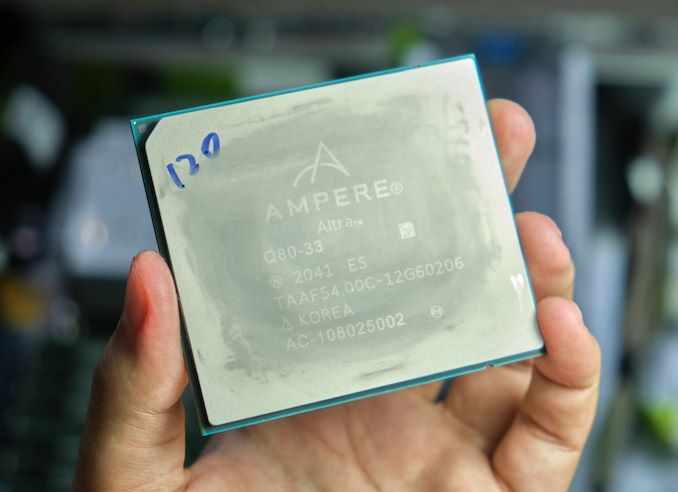
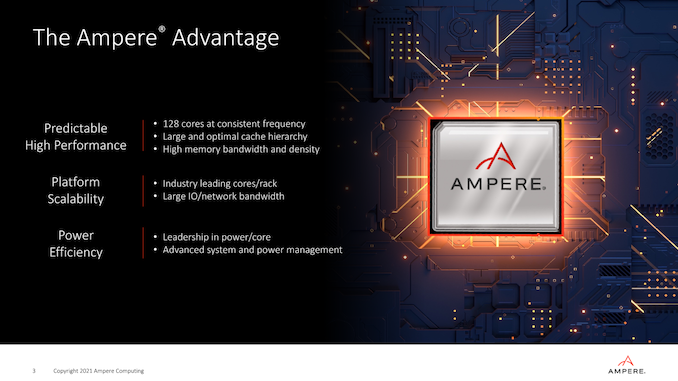
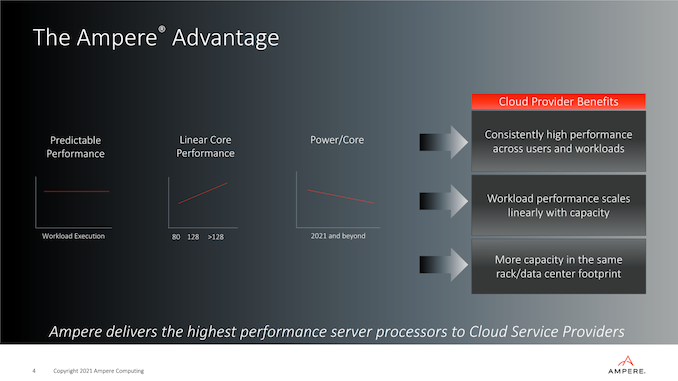
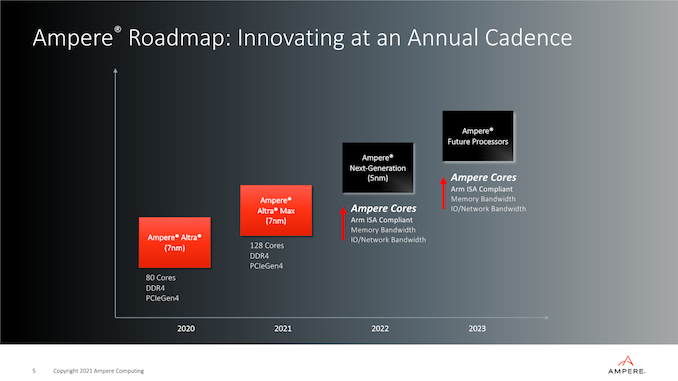
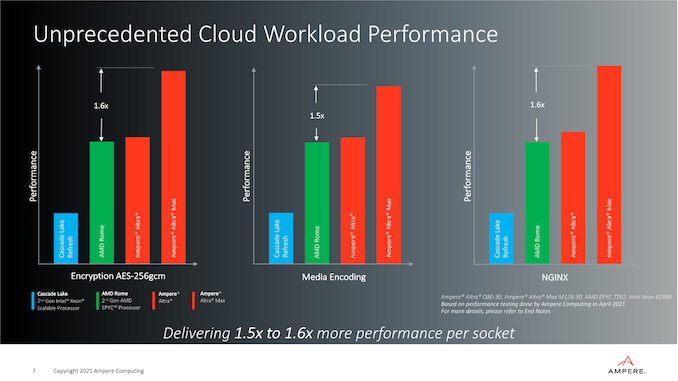
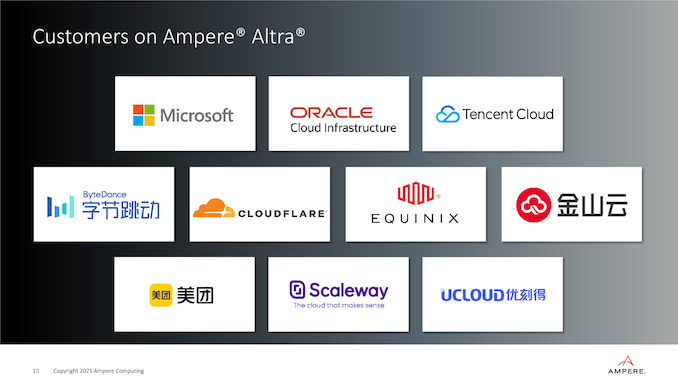








160 Comments
View All Comments
alfalfacat - Wednesday, May 19, 2021 - link
I think this must be it. If you're an pure IP house in the business of packaging someone else's IP, well you could make a decent systems integration business out of selling to smaller firms but not to hyperscalers who have more scale than you. I suspect enterprise/smb customers are sticking with x86, so you're getting squeezed out of both ends of the market.I agree that this is a surprising move, one that I don't know will pan out, but their alternative looks grim.
Yojimbo - Wednesday, May 19, 2021 - link
I think you are right. Why would a hyperscaler buy ARM-designed cores from Ampere when it can do the same modifications itself, except more tightly tuned to its individual needs? At the same time, the time frame for (potentially) selling ARM cores to enterprises is far beyond the financial viability of Ampere. So for Ampere it's a matter of survival to try to design its own cores. Plus having its own cores certainly makes it a better takeover target than having a business based on designing around ARM cores. Engineering teams can be hired away. IP stays with the company. Cf. Apple and Imagination Technologies. Imagination ended up being acquired by a Chinese company and Apple went back to licensing IP from it even after Apple had hired away a lot of its engineers. Ampere's hope is to develop and show something worth being acquired for, like Nuvia did.Matthias B V - Wednesday, May 19, 2021 - link
I agree.With most comanies starting own designs they just work on trying to increase value fast enough and then get sold for IP and especially Talent by a big player to extend their own capacities and talent.
serendip - Thursday, May 20, 2021 - link
Interesting. That's what Amazon did to get Graviton, buy a startup working on customized ARM cores to bring that expertise in-house. Microsoft could end up doing the same with Ampere but with the added bonus of having ARM-compatible custom cores like what Apple has. It's still important for ARM to continue licensing out core designs as a backup plan because any of these custom cores could go the way of Exynos.Thala - Wednesday, May 19, 2021 - link
Thing is, their engineering team is doing cores for decades as well - Intel x86-64 cores to be precise. At the moment, they just have to convincingly beat the x86 competition, which should be doable - beating other ARM offerings is of course going to be harder.mode_13h - Friday, May 21, 2021 - link
Yeah, they have to try and differentiate themselves from everyone else who's just taking ARMs stock IP. If custom doesn't work, they could always revert to using ARM's stock IP, but the big money is in substantially beating ARM, for at least a few market niches.I think they can probably do it, too. Especially if Neoverse continues to be just mobile cores on steroids.
Raqia - Wednesday, May 19, 2021 - link
Less reliance on ARM IP should nVidia consummate its deal is a plus for them too.dotjaz - Thursday, May 20, 2021 - link
There's absolutely no chance Nvidia can buy ARM. US will have to lift all the semi-conductor bans and promise never to do so again for China to approve the deal.Raqia - Thursday, May 20, 2021 - link
I agree with that. In addition, the disaffected CEO of ARM china is resisting the deal and seems to have the support of local authorities as well.sgeocla - Wednesday, May 19, 2021 - link
Milan is already out yet they are still comparing their next gen 2022 product against AMD previous generation EPYC Rome. By the time this launches they will compete with AMD EPYC Genoa with 50% more cores on 5nm so they are almost back to where they are now with 80 ARM cores vs. 64 x86 cores.If Ampere managed to learn anything from EPYC ramp over Xeon is that hey need to provide huge benefits and have a proven track record to gain market share, not just barely compete.